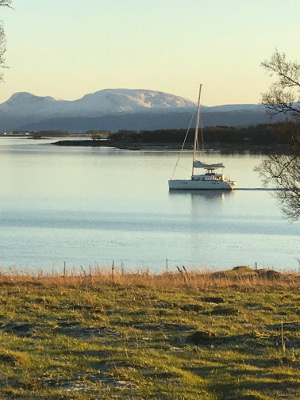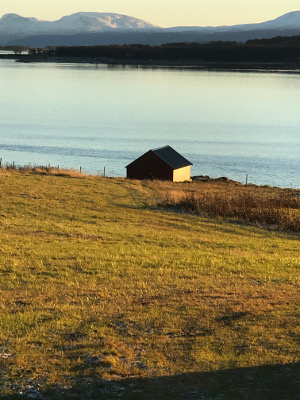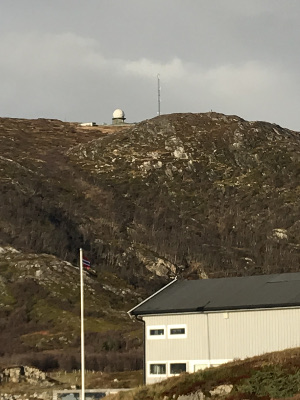TROMSO, Norway – Many of us who grew up on World War II books and films can recite the major European battles of the war by heart, from Normandy to Remagen to Stalingrad.
But it was here, in the far north of Scandinavia, that another facet of the war played out: a three-year cat-and-mouse game that ended with the sinking of the pride of the Third Reich’s navy, the Tirpitz.
Tirpitz was the big sister of the more famous battleship Bismarck. She was named for Grand Admiral Alfred von Tirpitz, who built the Imperial German Navy that stalemated the British fleet in World War I. The keel was laid in 1936 at a ceremony attended by Adolf Hitler, and Tirpitz was commissioned into the Kriegsmarine – the Reich’s naval forces – in 1941. At the time, it was the largest battleship ever launched by a European navy.
The British were so concerned about Tirpitz that they tried to destroy it in the shipyard before it was launched, and again during its brief initial tour in the Baltic Sea. The Royal Air Force bombers missed their mark, but it was obvious that Tirpitz was going to be a perennial Allied target.
Commanders in Berlin decided Tirpitz would be best used far from the main European battlefields, guarding the vital northern sea routes through which Allied convoys could reinforce the Soviet Union at the port of Murmansk, a few hundred miles east of Tromso. Although this region is well above the Arctic Circle, the last gasp of the Gulf Stream serves to keep the harbors ice-free. (The Murmansk region remains the headquarters of the Russian Northern Fleet to this day.)
Besides threatening Allied shipping to the Eastern front, Tirpitz served as a deterrent to an invasion of Norway, which the Germans had occupied in 1940. It also acted as a “fleet in being” – a single ship that was so threatening that it required the enemy to commit substantial forces to contain it. The British responded accordingly. They succeeded in keeping Tirpitz holed up in a Norwegian fjord not far from the Russian border for most of the war, repeatedly subjecting it to attacks from the air and from minisubmarines. But Tirpitz had a double-armored hull that resisted any serious damage until the British developed a massive 12,000-pound bomb, the Tallboy, which could pierce it.
Tirpitz fired its main guns in combat only once during the war, in a 1943 attack on the Allied-held Norwegian island of Spitzbergen in the high Arctic.
An attack in September 1944 left Tirpitz crippled and unseaworthy for extended voyages. The Germans moved the ship further south to Tromso, away from Russian airfields. But this put Tirpitz within range of specially modified British bombers taking off from Scotland, carrying the newly developed Tallboy.
 A pleasure boat sailing over the spot where Tirpitz rolled over
A pleasure boat sailing over the spot where Tirpitz rolled over
and partly sank. Photo by Larry Elkin.On Oct. 23, 1944, Soviet forces and Norwegians under the command of the government-in-exile invaded Finnmark – Norway’s northernmost county, adjacent to the Tromso region – and forced the Wehrmacht to retreat. The Germans adopted a scorched-earth policy, destroying Norwegian towns and forcing populations to relocate or flee. Only the native, nomadic Sami were exempt from the German relocation order.
 A farm shed with damage from Tirpitz-era bomb blasts.
A farm shed with damage from Tirpitz-era bomb blasts.
Photo by Larry Elkin.As the front collapsed from the north, RAF bombers again attacked from the south. On Nov. 12, they surprised Tirpitz before a nearby Luftwaffe protective force could take to the air. At least two Tallboys hit the ship, with others landing at close range in the water and onshore; the craters are still visible today. Within minutes, stores of ammunition aboard the ship exploded, and the battleship capsized. Estimates of the German dead range from about 1,000 to 1,200.
The liberating forces never reached Tromso. Finnmark was declared fully liberated on April 26, 1945, and Norwegian forces were poised on the Finnmark-Troms border. But the war in Europe ended on May 8 with the German surrender.
Most of Tirpitz was salvaged and sold for scrap in a joint Norwegian-German operation that ended in 1957. Today some of the wreckage, as well as a platform used in the salvage operation, remain in the water where the ship sank, and some of the scars of the battle are visible nearby.
 The view near Sommaroy, Norway. Photo by Linda Field Elkin.
The view near Sommaroy, Norway. Photo by Linda Field Elkin.Northern Norway remains a strategically important area. As I write this in the coastal village of Sommaroy, I can see a radar dome and a radio mast atop a nearby hill. The installation is controlled by the Norwegian military, and thus serves as part of NATO’s defense network. The offshore seabed here also probably has more microphones than Beyonce’s recording studio, to pick up Russian subs heading to and from north Atlantic waters. Some areas inland were militarily restricted zones until after the Cold War in the 1990s.
World War II ended a long time ago, but despite today’s tranquil landscapes it has never gotten very far away, even in the remotest corner of the continent where it began.
Posted by Larry M. Elkin, CPA, CFP®
The Tirpitz and other battleships in Norway, October 1942. Photo by "Boeckmann," courtesy the German National Archives.
TROMSO, Norway – Many of us who grew up on World War II books and films can recite the major European battles of the war by heart, from Normandy to Remagen to Stalingrad.
But it was here, in the far north of Scandinavia, that another facet of the war played out: a three-year cat-and-mouse game that ended with the sinking of the pride of the Third Reich’s navy, the Tirpitz.
Tirpitz was the big sister of the more famous battleship Bismarck. She was named for Grand Admiral Alfred von Tirpitz, who built the Imperial German Navy that stalemated the British fleet in World War I. The keel was laid in 1936 at a ceremony attended by Adolf Hitler, and Tirpitz was commissioned into the Kriegsmarine – the Reich’s naval forces – in 1941. At the time, it was the largest battleship ever launched by a European navy.
The British were so concerned about Tirpitz that they tried to destroy it in the shipyard before it was launched, and again during its brief initial tour in the Baltic Sea. The Royal Air Force bombers missed their mark, but it was obvious that Tirpitz was going to be a perennial Allied target.
Commanders in Berlin decided Tirpitz would be best used far from the main European battlefields, guarding the vital northern sea routes through which Allied convoys could reinforce the Soviet Union at the port of Murmansk, a few hundred miles east of Tromso. Although this region is well above the Arctic Circle, the last gasp of the Gulf Stream serves to keep the harbors ice-free. (The Murmansk region remains the headquarters of the Russian Northern Fleet to this day.)
Besides threatening Allied shipping to the Eastern front, Tirpitz served as a deterrent to an invasion of Norway, which the Germans had occupied in 1940. It also acted as a “fleet in being” – a single ship that was so threatening that it required the enemy to commit substantial forces to contain it. The British responded accordingly. They succeeded in keeping Tirpitz holed up in a Norwegian fjord not far from the Russian border for most of the war, repeatedly subjecting it to attacks from the air and from minisubmarines. But Tirpitz had a double-armored hull that resisted any serious damage until the British developed a massive 12,000-pound bomb, the Tallboy, which could pierce it.
Tirpitz fired its main guns in combat only once during the war, in a 1943 attack on the Allied-held Norwegian island of Spitzbergen in the high Arctic.
An attack in September 1944 left Tirpitz crippled and unseaworthy for extended voyages. The Germans moved the ship further south to Tromso, away from Russian airfields. But this put Tirpitz within range of specially modified British bombers taking off from Scotland, carrying the newly developed Tallboy.
A pleasure boat sailing over the spot where Tirpitz rolled over
and partly sank. Photo by Larry Elkin.
On Oct. 23, 1944, Soviet forces and Norwegians under the command of the government-in-exile invaded Finnmark – Norway’s northernmost county, adjacent to the Tromso region – and forced the Wehrmacht to retreat. The Germans adopted a scorched-earth policy, destroying Norwegian towns and forcing populations to relocate or flee. Only the native, nomadic Sami were exempt from the German relocation order.
A farm shed with damage from Tirpitz-era bomb blasts.
Photo by Larry Elkin.
As the front collapsed from the north, RAF bombers again attacked from the south. On Nov. 12, they surprised Tirpitz before a nearby Luftwaffe protective force could take to the air. At least two Tallboys hit the ship, with others landing at close range in the water and onshore; the craters are still visible today. Within minutes, stores of ammunition aboard the ship exploded, and the battleship capsized. Estimates of the German dead range from about 1,000 to 1,200.
The liberating forces never reached Tromso. Finnmark was declared fully liberated on April 26, 1945, and Norwegian forces were poised on the Finnmark-Troms border. But the war in Europe ended on May 8 with the German surrender.
Most of Tirpitz was salvaged and sold for scrap in a joint Norwegian-German operation that ended in 1957. Today some of the wreckage, as well as a platform used in the salvage operation, remain in the water where the ship sank, and some of the scars of the battle are visible nearby.
The view near Sommaroy, Norway. Photo by Linda Field Elkin.
Northern Norway remains a strategically important area. As I write this in the coastal village of Sommaroy, I can see a radar dome and a radio mast atop a nearby hill. The installation is controlled by the Norwegian military, and thus serves as part of NATO’s defense network. The offshore seabed here also probably has more microphones than Beyonce’s recording studio, to pick up Russian subs heading to and from north Atlantic waters. Some areas inland were militarily restricted zones until after the Cold War in the 1990s.
World War II ended a long time ago, but despite today’s tranquil landscapes it has never gotten very far away, even in the remotest corner of the continent where it began.
Related posts: